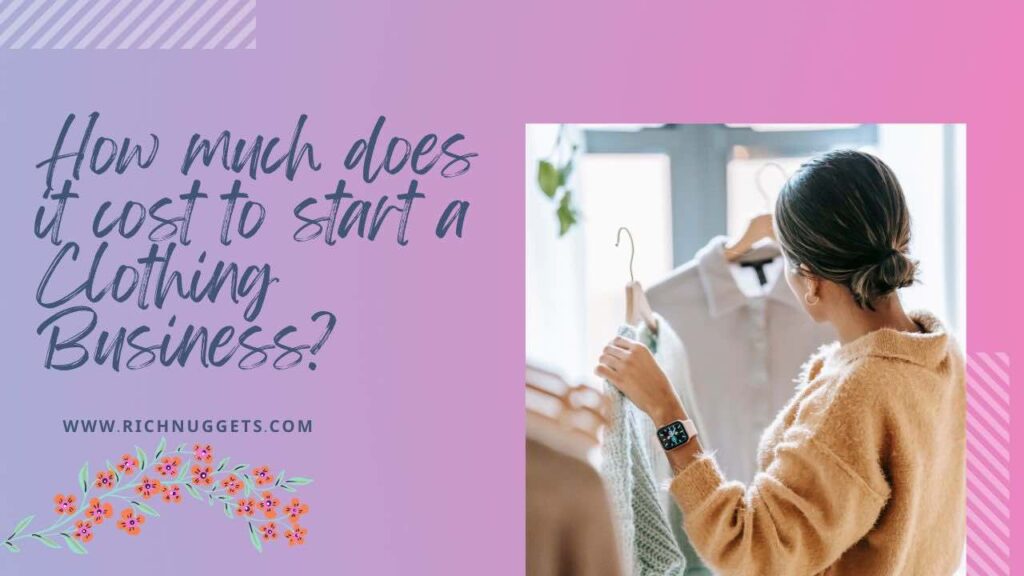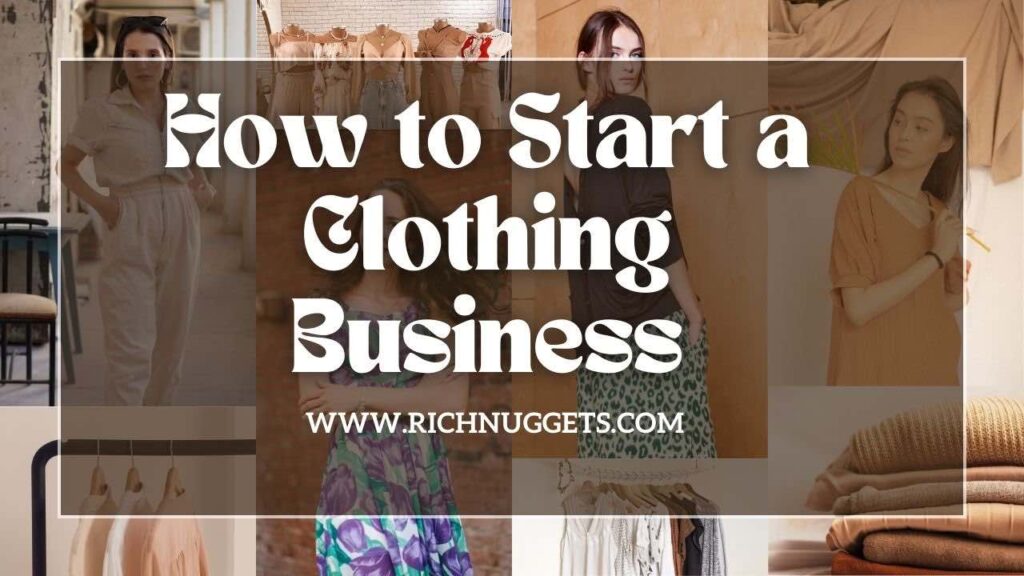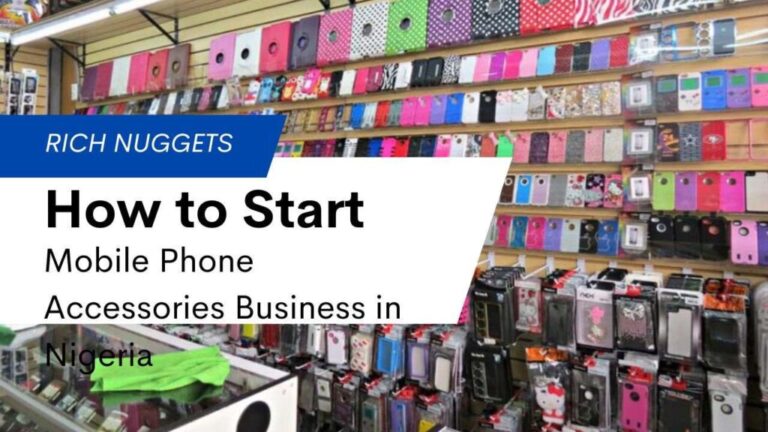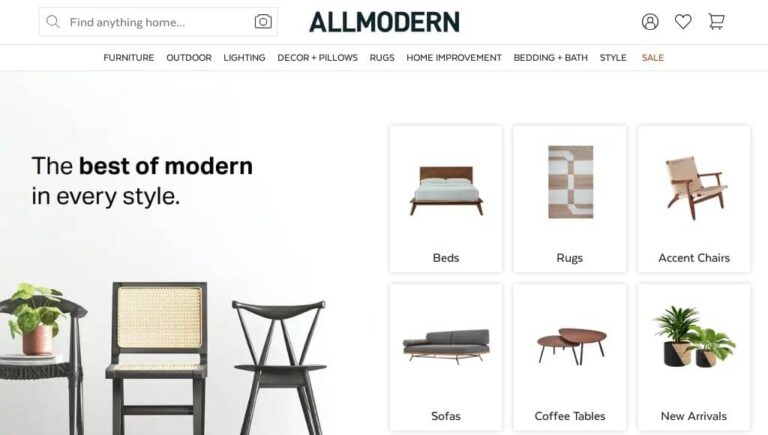
You have the passion and creativity to start a clothing business, but now you want to learn how to actually begin. Well, welcome to the right place!
Entering a creative industry like fashion requires more than just skill and passion. You must also seek guidance and possess knowledge on the business side; otherwise, you may end up spending without recouping the benefits.
In this article, our objective is to simplify the process by providing you with the necessary steps and strategies needed to start your clothing business with confidence.
For those who possess the creativity to start this business but are doubting their passion for it, this article will also help you with the fundamental aspects of starting and running a successful clothing business.
Before we delve into how to start a clothing business, let’s take a brief tour of other important variables that will boost your confidence in starting this venture.
Table of Contents
How much does it cost to start a Clothing Business?

The initial investment needed to launch a clothing line can differ significantly. Typically, a small-scale clothing line necessitates a minimum of $500 to $1,000 to commence, while a medium-sized line typically requires startup costs ranging from $2,000 to $5,000.
On the other hand, a larger clothing line may require a more substantial investment, falling within the range of $50,000 to $150,000.
How Profitable Is Clothing Business

According to fashion analysts, retailers typically experience profit margins ranging from 4 to 13 percent. This means that an investment of $1,000 can potentially bring a return of $1,040 to $1,130. While these margins may seem relatively low, they should not discourage you from starting your clothing business.
According to Statista, the global apparel market witnessed significant growth in 2022, generating approximately 1.5 trillion U.S. dollars in revenue. This positive trend is expected to continue, with industry forecasts projecting further growth. By 2027, the revenue is estimated to reach nearly 2 trillion dollars, indicating a promising future for the apparel market.
So there is nothing to worry about because the clothing business offers a high turnover potential.
However, in order to attract high turnover, it is crucial to focus on selling only high-quality clothes, regardless of the clothing niche you have in mind or have already chosen.
What type of Clothing is most profitable?

When starting a clothing business, it is advised you focus on a single niche (that is one particular type of clothing)
Mind you, going for a particular type of clothing doesn’t mean you can not include a small quantity of other types of clothing.
The primary reason for concentrating on a particular clothing niche is to establish a clear identity for yourself, distinguishing you from your competitors. Even if you decide to incorporate additional clothing niches, they should complement your main niche.
For example, if you choose to sell men’s shoes as your main niche, you could also consider offering designer socks, men’s bow ties, and designer eyewear. This approach indirectly encourages your customers to make additional purchases as these items have a complementary demand.
If you are seeking the most profitable type of clothing to start your business with, here is a list of the most in-demand clothing items in the market.
- Designer Women’s Clothing: Such as; Dresses, Shirts, Blouses, Jackets, Suits and Blazers, Jeans and Pants, Designer Women’s Handbags
- Designer Sleepwear for Women
- Designer Shoes
- Designer Eyewear
- Designer Lingerie
- Designer Men’s Bow Ties
- Designer Socks
- Designer Jewelry
- Designer Watches
How to Start a Clothing Business

1. Choose your niche
When establishing a clothing business, one of the crucial decisions which is also a personal decision that you must make, is to determine the specific niche your business will cater to.
Your brand can focus on a particular market, such as sustainable and eco-friendly clothing or trendy streetwear.
Designing or selling for a diverse range of customers, and embracing inclusivity across gender identities and body types, can present challenges in achieving success.
By narrowing down your target demographic or customer base, you can develop a more concentrated brand identity and business model.
Furthermore, aspiring entrepreneurs can select clothing designs based on their cost of production, buying cost, or demand in the clothing industry.
But for whatever reason that made you choose a particular brand for your clothing business, one thing is not up for discussion, and that is quality; the quality must be topnotch.
Embrace the power of your niche, as it is the foundation of your brand’s identity. It not only distinguishes you from the crowd but also establishes your legacy.
2. Analyze Your Target Audience
Once you have established your brand identity, the subsequent phase involves identifying your customer base.
To effectively identify your target audience, it is essential to ask yourself several key questions:
1. Who are they? Gain a clear understanding of the demographics, lifestyles, and characteristics of your potential customers. Consider factors such as age, gender, occupation, and interests.
2. Where do they shop? Identify the shopping destinations preferred by your target audience. Whether it’s online retailers, department stores, boutique shops, or specific platforms, understanding their shopping habits will enable you to reach them more effectively.
3. How often do they shop? Determine the frequency at which your audience engages in shopping activities. Are they regular shoppers or more selective in their purchasing behavior? This insight will help you plan your marketing and product release strategies.
4. What is their price point? Understand the price range that aligns with your audience’s purchasing power and willingness to spend. This information will guide your pricing strategy and product offering.
5. What influences their buying decisions? Identify the key factors that drive your audience’s purchasing choices. This could include factors such as quality, sustainability, brand reputation, celebrity endorsements, or social media influence.
6. Do they identify with certain brands? Determine whether your audience actively seeks to align themselves with specific brands that reflect their personal identity or values. This knowledge will assist you in positioning your clothing line appropriately.
7. What are their favorite clothing brands? Explore the established brands that resonate with your target audience. This insight will help you understand their style preferences and the values they associate with particular brands.
8. Do they care about trends? Assess the importance of trends to your target audience. Determine whether they are fashion-forward individuals who eagerly embrace the latest styles or if they prioritize timeless and classic designs.
By providing comprehensive responses to these inquiries, you will acquire invaluable knowledge about your target audience, empowering you to customize your clothing business in a manner that more effectively meets their preferences and requirements.
3. Name your Clothing Business or Brand
Picking the perfect name for your clothing business is a big deal! It sets the vibe for your brand and it is the first thing people notice.
Therefore, selecting a name that is distinctive, memorable, and genuinely reflects your brand is exceedingly crucial.
Here are some guidelines to assist you in choosing an exceptional business name for your clothing line:
Simplicity and memorability: Opt for a name that is uncomplicated to pronounce, spell, and recollect. Complex words or phrases can confuse people or slip their minds.
Let it be one of a kind: Stand out from the crowd by choosing a name that’s original and not commonly used within the clothing industry. Steer clear of generic terms that can make it challenging for customers to differentiate your brand from others.
Let it showcase your brand’s personality: Your business name should capture what your brand is all about—its values, mission, and vibe. It should give people a sense of what makes your clothing line special and unique.
Let the name reflect future growth: While it’s important to choose a name that fits your current offerings, also consider how it’ll work if you expand in the future. Avoid names that limit you and make it tough to diversify your product line as your brand grows.
Check if it’s available: Before you make it official, do your homework! Research to make sure the name you want is up for grabs and doesn’t have any trademark issues. You don’t want any legal troubles down the road.
By following these tips, you are on your way to picking a killer business name that captures the spirit of your clothing line, attracts customers, and sets the stage for your brand’s epic success!
4. Create a Business Plan
Developing a comprehensive plan for the first five years of your clothing line is crucial for success and attracting potential investors.
By outlining specific and measurable goals and detailing actionable steps and strategies, you can showcase your vision and the viability of your business.
When crafting your business plan, include the following sections to provide a complete overview:
Executive Summary:
- Describe the clothing line you plan to offer, highlighting its unique features and value proposition.
- Present a concise mission statement that encapsulates your brand’s purpose and goals.
- Provide information about key team members, including any additional employees or managers involved in the business.
Company Description:
- Illustrate how your clothing line distinguishes itself from existing market players. Emphasize the unique aspects of your products and the competitive advantages they offer.
- Define your target customers and outline their demographics, preferences, and needs.
Market Analysis:
- Conduct thorough market research to assess the industry outlook and trends.
- Analyze competitors, their offerings, pricing strategies, and market share.
- Identify opportunities and gaps in the market that your clothing line can capitalize on.
Organization and Management:
- Describe the legal entity structure you have chosen for your business, it can be a sole proprietorship, partnership, limited liability company, or another form.
- Outline the roles and responsibilities of key members in your organization, including their expertise and relevant experience.
Product Description:
- Provide a detailed overview of your clothing line, including the types of garments, materials used, design aesthetics, and any unique selling points.
- Highlight the quality, craftsmanship, sustainability, or other distinctive features that set your products apart.
Marketing and Sales:
- Outline your marketing and branding strategy, including the channels and platforms you will utilize to reach your target audience.
- Define your pricing strategy, distribution channels, and plans for sales and promotions.
- Detail your customer acquisition and retention strategies, emphasizing how you will build brand awareness and loyalty.
Financial Projections:
- Provide a detailed overview of the financial forecast for the upcoming five years, encompassing projected revenue, expenses, and overall profitability.
- Include balance sheets, income statements, and budgets to demonstrate your financial goals.
- Ensure your projections are realistic, based on thorough market research and sound financial analysis, avoiding any embellishment of numbers.
By incorporating these sections into your business plan, you will provide potential investors with a clear understanding of your clothing line’s direction, market positioning, and financial potential, increasing the attractiveness of your business for investment opportunities.
5. Register your Business and Get Business Permits
You don’t want to be at loggerheads with the government, especially when it comes to laws governing the country or state/region on business activities.
So in order to avoid business disruptions from the government, take the following steps to ensure your business is properly established:
a) Choose the right business entity type:
Select the most suitable business structure for your clothing line, such as a Sole proprietorship, Limited Liability Company, or Corporation. But note that, each business structure comes with its own advantages and disadvantages. So do well to seek help from a legal professional and from a business consultant before you decide to settle for any business entity.
It is recommended to start with a sole proprietorship if you are venturing into the clothing line business on a small or medium scale.
But as profit and turnover continue to increase and you feel the need to expand your brand, you can easily transition to other business entities such as a Limited Liability Company (LLC).
b) Register your business:
Now you have chosen your business entity, the next thing to do is to officially register your business with the relevant authorities.
Consider filing a DBA (Doing Business As) to formally register your chosen business name.
c) Obtain necessary licenses and permits:
In most cases, you will need a general business operating license to officially commence your clothing line business.
If you operate primarily online, permits, such as a sales tax license will be required.
To ensure compliance with all licensing and permitting requirements, reach out to the relevant state and local governing agencies.
d) Obtain an employer identification number (EIN):
Registering for an EIN with the IRS is an essential step for any business, including a clothing line. While not mandatory for all businesses, obtaining an EIN can facilitate tax filing, enable the opening of a business bank account, and provide access to business financing.
By efficiently addressing these administrative tasks, you can establish a solid foundation for your clothing line business and focus on bringing your creative vision to life.
6. Decide on your Business Model
When it comes to establishing your clothing business, selecting the right business model is key to standing out from the competition and unleashing your brand’s uniqueness. Consider these innovative and unique five(5) options:
1. Collaborative Design:
Embrace the power of collaboration by partnering with skilled cut and sew manufacturers. This approach allows you to bring your visionary designs to life, creating a collection that seamlessly blends artistry and functionality.
By offering exclusive and customized clothing items, you can captivate your audience and showcase your creative genius.
2. Artisan Craftsmanship:
Emphasize the beauty of handmade clothing by showcasing your artistic skills and attention to detail. Choose the finest materials, from luxurious fabrics to intricate embellishments, and craft one-of-a-kind pieces.
Selling your exquisite creations through specialized platforms like Etsy or your own captivating website will attract customers seeking unique and carefully crafted garments.
3. Sustainable Fashion:
Build a brand that focuses on ethical practices and environmental consciousness. Collaborate with eco-friendly suppliers and manufacturers to create clothing lines that prioritize sustainability.
By educating consumers about the positive impact of their choices, you can foster a greener and more conscious fashion industry.
4. Print-on-Demand Artistry:
Transform ordinary garments into wearable masterpieces by infusing them with your imaginative graphic designs. Explore print-on-demand services that utilize advanced printing techniques to bring your artistic visions to life.
Offering personalized, limited-edition clothing items allows customers to express their individuality while enjoying the exclusivity of your creations.
5. Virtual Showrooms:
Revolutionize the retail experience by creating immersive virtual showrooms. Utilize cutting-edge technology to provide customers with a unique and interactive shopping experience from the comfort of their homes.
Through 3D visualizations, virtual fittings, and personalized styling recommendations, you can captivate your audience and differentiate your brand in the digital landscape.
Remember, the business model you choose will shape the trajectory of your clothing brand. Embrace your uniqueness, dare to be different, and let your selected business model reflect the innovation and creativity at the core of your clothing line.
7. Build your online storefront (Website)
Surprisingly, recent studies indicate that close to 100% of consumers conduct online research before making a purchase.
This statistic underscores the significant role your website plays in your overall marketing and branding strategy.
To optimize this essential business tool for your clothing line, consider the following steps:
1. Reflect your brand through website design:
Your website should serve as a visual representation of your brand. Incorporate design elements, color schemes, and typography that align with your clothing line’s unique identity.
By creating a cohesive and visually appealing website, you can effectively convey your brand’s message to potential customers.
2. Showcase your clothing designs:
A key aspect of promoting your clothing line is to prominently display your designs on your website. Utilize high-quality product images and compelling visuals that capture the attention of visitors.
Include multiple views, close-ups, and the ability to zoom in for a closer look. This allows potential customers to appreciate the details and craftsmanship of your garments.
3. Offer customization options:
To cater to the diverse preferences of consumers, consider providing customization options on your website.
This could include features like color variations, size options, or the ability to personalize garments with monograms or custom prints.
By offering these choices, you can enhance customer engagement and provide a more personalized shopping experience.
4. Establish credibility and legitimacy:
In an increasingly crowded online marketplace, it’s essential to build trust with your website visitors.
Display customer testimonials, reviews, and ratings to demonstrate the satisfaction of previous customers. Incorporate trust badges, secure payment options, and clear return policies to instill confidence in potential buyers.
In addition make ensure that your website is secure, user-friendly, and optimized for mobile devices to enhance the overall user experience.
By investing time and effort in creating a website that accurately meets the prementioned requirements, you will be able to drive growth and success for your clothing line.
8. Source Funding
When starting a clothing line, self-funding can be a prudent approach to avoid debt. However, if you require external assistance, various business financing options are available, such as;
Self-Funding:
Self-funding remains the most common option of funding, but it’s important to assess whether your savings alone will sustain your business or hinder its growth. While it may be a prudent choice for the initial stages, explore alternative funding options to fuel expansion.
Business Loans:
Apart from traditional banks and online business lenders, other financing avenues can provide the necessary capital. Venture capital firms and private investors who specialize in the fashion industry are often interested in supporting promising ventures. These entities can provide not just financial resources but also valuable expertise and networking opportunities.
Business Lines of Credit:
While banks and online lenders offer lines of credit, it’s worth exploring additional options. Industry-specific credit unions or organizations that support small businesses, particularly those in the fashion sector, may provide tailored lines of credit with favorable terms. These institutions understand the unique challenges and potential of the clothing industry, making them ideal partners.
Grants and Competitions:
Research and apply for grants and competitions that specifically target entrepreneurs in the fashion industry. Numerous organizations and foundations offer financial support and mentoring programs to emerging designers. These opportunities can provide not only funding but also exposure and credibility for your clothing line.
Partnerships and Collaborations:
Consider establishing partnerships or collaborations with established brands, retailers, or manufacturers. Such alliances can provide financial support through joint investments, production partnerships, or distribution agreements. Additionally, they offer opportunities to leverage existing networks, gain brand recognition, and access new customer bases.
Angel Investors:
Angel investors are individuals who provide funding to startups in exchange for equity or convertible debt. Seek out angel investors who have an interest in the fashion industry or who value the creativity and innovation your clothing line brings. Angel investors often provide not only financial resources but also mentorship and guidance to help your business thrive.
By leveraging a diverse range of funding sources, you can propel your clothing line toward success while establishing a strong foundation for future growth.
9. Promote Your Clothing Brand Effectively
In order to ensure the success of your clothing brand, it is crucial to implement effective marketing strategies that will allow your target audience to discover your products. There are several avenues available for marketing a clothing business, but the key is to select channels that effectively reach your specific target market. In essence, it is important to position your brand where your potential customers can easily find it.
Outlined below are some of the most popular and effective marketing channels and strategies for clothing brands:
Content Marketing: Develop and share valuable, informative content related to your brand, such as blog posts or videos, to attract and engage potential customers.
Social Media Marketing: Utilize platforms such as Facebook, Pinterest, Instagram, and YouTube to showcase your brand, create targeted campaigns, and engage with your audience.
Influencer Marketing: Collaborate with influential individuals in your niche who can promote your clothing brand to their dedicated followers.
Forums: Engage with online communities like Reddit, where you can actively participate in relevant discussions and promote your clothing brand subtly.
Google Ads: Utilize platforms like Google AdSense to display visually appealing ads across relevant websites, and Google search engine, increasing brand visibility and driving traffic to your online store.
Paid Placements: Seek opportunities to have your products featured in magazines, online publications, or influential blogs that align with your brand values.
E-commerce Ads: Take advantage of advertising options on popular e-commerce platforms such as Amazon Ads, Ali Baba Ads, and Etsy Ads to reach a wider customer base.
Search Engine Optimization (SEO): Optimize your website and product pages to improve your search engine rankings, making it easier for potential customers to find your brand.
Email Marketing: Build a mailing list and send regular newsletters or promotional emails to engage with existing customers and nurture potential leads.
Local Events: Participate in local fashion shows, exhibitions, or community events to establish a presence within your community and connect with potential customers.
Sponsorships: Collaborate with relevant events or organizations to sponsor their activities and increase brand visibility within your target market.
Local News: Reach out to local news outlets to secure coverage or features that highlight your clothing brand and its unique offerings.
When selecting marketing strategies and channels for your clothing business, it is vital to align them with your brand identity. Also utilizing multiple marketing channels will maximize your brand exposure and increase the likelihood of reaching your target audience effectively.
10. Business Insurance
If you’re venturing into the clothing business using whatever business model you decide to settle with, it’s crucial to consider safeguarding your small business right from the start.
Investing time and resources into your clothing business makes it all the more necessary to protect your efforts, and that’s where business insurance comes into play.
A comprehensive insurance plan can provide coverage for various aspects of your clothing business. Here are the three most popular clothing business insurance policies;
1. Online retailer insurance
This insurance policy can protect you from potential risks associated with running an e-commerce store.
It covers potential liabilities that may arise due to online transactions, ensuring you’re shielded from financial losses caused by events like data breaches or cyber-attacks.
2. Product liability insurance
This insurance policy is another vital component of your insurance strategy. It safeguards your business against claims arising from defective products that could cause harm to your customers.
Accidents or injuries resulting from clothing purchased through your online or physical store can lead to costly legal battles, but with proper product liability coverage, you can rest easy knowing that you have financial protection in place.
3. Stock insurance cover
When it comes to stock, having an appropriate stock cover is essential. This type of insurance shields your business from losses caused by events like theft, damage, or loss of inventory.
As a clothing business owner, your stock is your lifeline, and protecting it ensures you’re prepared to handle unforeseen circumstances that could negatively impact your operations.
By obtaining business insurance you’re not only safeguarding your small business but also securing peace of mind.
Key resources:
- How to Start a Ecommerce Business
- How to Start a Dropshipping Business
- How to Start a Small Business
- How to Start a Business Online
- How to Start a Business with No Money
Conclusion
When it comes to determining the price at which you will be selling your clothes, it will depend on if you are going to be manufacturing them or procuring them from independent manufacturers.
If you are going to manufacture them, the prices of the clothes will be determined by the cost at which they were manufactured.
But if you decide to procure them, the price will be determined by two major factors; the cost of procuring each of the clothes and the quality of the clothes.
Asking, how many items should you start a clothing business? The recommended clothes items you need to start a clothing business, shouldn’t be less than 50 items of clothes.
And if you are to know how many of the clothes you need to sell to start making profits then you will need to use the “Breakeven Analysis” to calculate that.
That’s all about how to start a clothing business. If you have any questions or contributions, please leave them in the comment section below.
Remember to turn on the Bell 🔔 Notification to get updated directly on your device when new articles are published.





